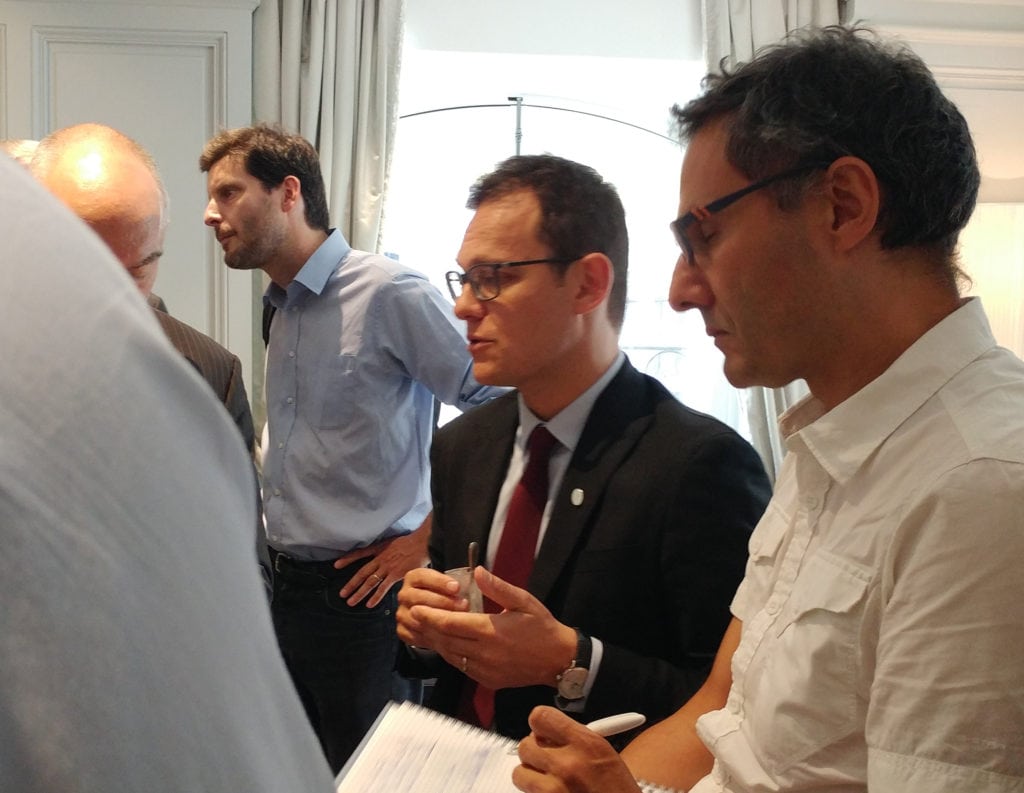Latest News

Arianespace CEO Stephane Israel (center) during a press conference Sept. 12, 2016. Photo: Via Satellite
[Via Satellite 09-14-2016] Following the explosion of SpaceX’s Falcon 9 rocket with Spacecom’s Amos 6 satellite, Arianespace CEO Stephane Israel said satellite operators have reached out to the company to inquire about launch services. However, the European launch services provider has only one launch slot for a large satellite available between now and the end of 2018. Speaking Sept. 12 at a press conference, Israel said the Arianespace manifest is the fullest it’s ever been, and the company is trying to create room for more launches to accommodate near-term demand.
“We are almost full up to 2018 with one opportunity for a big satellite in 2018,” he said, adding that Arianespace is endeavoring to offer additional launch slots “with Soyuz as a backup for small satellites, and by introducing one more Ariane next year and the year after.”
At present, Arianespace has 56 missions in its backlog spread across Vega, Soyuz and its flagship Ariane 5 rocket. Israel said 22 future missions are with Ariane 5, 24 with Soyuz, and 10 are with Vega. The addition of OneWeb’s bulk purchase of 21 Soyuz missions last year accounts for the majority of that rocket’s use. Other launch vehicle missions are more diversified between customers in telecom, navigation, remote sensing, and science.
This year the company added eight more missions to its manifest — two for Vega and six for Ariane 5. Including the recently announced GSAT 11 multi-spot beam satellite for the Indian Space Research Organization (ISRO), scheduled to launch in 2017, other Ariane 5 additions consist of Comsat NG 1 and 2 for the French procurement agency DGA, ViaSat 2 on behalf of ViaSat and two undisclosed customers. The Vega missions are for the Capacité de Renseignement d’origine Electromagnétique Spatiale (CERES) DGA-CNES satellite and the Atmospheric Dynamics Mission (ADM-Aeolus) for the European Space Agency (ESA).
Israel said while Arianespace has limited room for new missions, it is not entirely out of options, and would be willing to work with satellite operators seeking new contracts. Whether or not operators could switch launch providers, as some have apparently queried about, is subject to whether or not they have the contractual flexibility to do such a swap, he said. Given the small size of the launch market, vehicle failures can easily compound delays for satellite operators. In light of this, Israel encouraged discussion between launch providers on the topic of shifting customers from one vehicle to another.
“I think it is good that different competitors speak to each other for the benefit of the customer,” he said. “We know that in our business we all can have some difficulties. And it could be the case of Arianespace, we will see, I hope not, but we all can have some difficulties.”
Arianespace has completed six missions this year — four with Ariane 5 and two with Soyuz — and is pursuing 11 in total. This number is down from an initially planned 12 due to a lost launch opportunity caused by a satellite-shipping problem. Were it not for the shipping incident, the launch provider would be on pace to match last year’s 12-mission cadence, which set a company record. The remaining 2016 missions consist of two Vega and three Ariane 5 missions.
Last year Arianespace shifted EchoStar’s Jupiter 2 mission to United Launch Alliance (ULA) to accommodate EchoStar’s desire to launch this year. Israel mentioned this flexibility as proof of Arianespace’s willingness to put its money where its mouth is.
“If a different launch service provider wants to work with us on creative solutions, our door is open,” he said.
One customer, ViaSat, did switch its ViaSat 2 High Throughput Satellite (HTS) from SpaceX’s Falcon Heavy to an Ariane 5, as SpaceX’s Commercial Resupply Services-7 (CRS-7) mission failure pushed back the rocket’s debut. Israel also criticized SpaceX’s method of continually augmenting its launch vehicle, saying launch providers need to find a balance between improvement and cautiousness.
“I would be cautious when it comes to changing each rocket launch after launch. This is not what we have done with Ariane 5 … the more we can have a launch looking like the previous I think the better it is for our customers,” he said.
Israel said Arianespace has made limited improvements to the Ariane 5 chiefly by “exploiting the launch and better understanding the margins” of the vehicle rather than making significant changes to the vehicle. Rather than “over-innovating” and have an “unstable system,” Israel said Arianespace sought to stabilize the Ariane 5 as a lesson learned from the rocket’s one failure in 2002. He said Arianespace took two years and three months before returning to flight in 2005 with the Ariane 5 ECA version.
Israel pointed to the Ariane 6 with Vega C as evidence of the company’s pursuit of innovation. This summer the company held its first workshops for future customers of the Ariane 6 and Vega C launchers, and plans to begin selling launches for both by the end of the year. Vega C is expected to debut in mid-2019, followed by the Ariane 6 in 2020. Israel said Arianespace intends to have an overlap period of three years before phasing out today’s launch family.
Get the latest Via Satellite news!
Subscribe Now